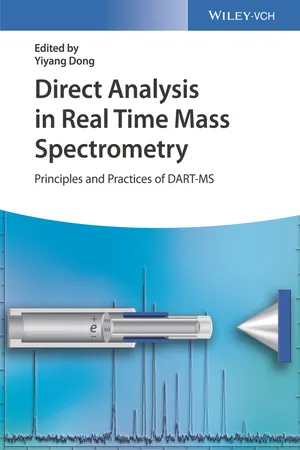
Direct Analysis in Real Time Mass Spectrometry
Principles and Practices of DART-MS
- English
- ePUB (mobile friendly)
- Available on iOS & Android
About This Book
Clear, comprehensive, and state of the art, the groundbreaking book on the emerging technology of direct analysis in real time mass spectrometry Written by a noted expert in the field, Direct Analysis in Real Time Mass Spectrometry offers a review of the background and the most recent developments in DART-MS. Invented in 2005, DART-MS offers a wide range of applications for solving numerous analytical problems in various environments, including food science, forensics, and clinical analysis. The text presents an introduction to the history of the technology and includes information on the theoretical background, for exampleon the ionization mechanism. Chapters on sampling and coupling to different types of mass spectrometers are followed by a comprehensive discussion of a broad range of applications. Unlike most other ionization methods, DART does not require laborious sample preparation, as ionization takes place directly on the sample surface. This makes the technique especially attractive for applications in forensics and food science. Comprehensive in scope, this vital text: -Sets the standard on an important and emerging ionization technique
-Thoroughly discusses all the relevant aspects from instrumentation to applications
-Helps in solving numerous analytical problems in various applications, for example food science, forensics, environmental and clinical analysis
-Covers mechanisms, coupling to mass spectrometers, and includes information on challenges and disadvantages of the technique Academics, analytical chemists, pharmaceutical chemists, clinical chemists, forensic scientists, and others will find this illuminating text a must-have resource for understanding the most recent developments in the field.
Frequently asked questions
Information
Chapter 1
Introduction of Mass Spectrometry and Ambient Ionization Techniques
1.1 Evolution of Analytical Chemistry and Its Challenges in the Twenty-First Century



Table of contents
- Cover
- Title Page
- Copyright
- Dedication
- Table of Contents
- Preface
- About the Editor
- Chapter 1: Introduction of Mass Spectrometry and Ambient Ionization Techniques
- Chapter 2: DART Mass Spectrometry: Principle and Ionization Facilities
- Chapter 3: Sampling and Analyte Enrichment Strategies for DART-MS
- Chapter 4: Optimization of DART and Mass Spectrometric Parameters
- Chapter 5: Interfacing DART to Extend Analytical Capabilities
- Chapter 6: Application of DART-MS in Foods and Agro-Products Analysis
- Chapter 7: Application of DART-MS for Industrial Chemical Analysis
- Chapter 8: Application of Direct Analysis in Real Time Coupled to Mass Spectrometry (DART-MS) for the Analysis of Environmental Contaminants
- Chapter 9: Application of DART-MS in Clinical and Pharmacological Analysis
- Chapter 10: DART-MS Applications in Pharmaceuticals
- Chapter 11: Application of DART-MS in Natural Phytochemical Research
- Chapter 12: Miscellaneous Applications of DART-MS
- Chapter 13: Inherent Limitations and Prospects of DART-MS
- Index
- End User License Agreement